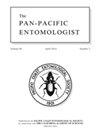凤尾蜂属蜜蜂的七个替代名称,1896年(膜翅目:凤尾蜂科:Panurginae)
IF 0.6
4区 农林科学
Q4 ENTOMOLOGY
引用次数: 0
摘要
Protandrenini是一个由436种andrenid蜜蜂组成的新世界部落(Ascher&Pickering 2022,Bossert等人2022)。北美鱼精蛋白形成了186个物种的单一分支(Bossert等人2022,Ramos等人2022)(Ascher和Pickering 2022)。在过去的170年里,北美蜂被分为许多不同的属,包括1848年的Panurginus Nylander和1868年的Psaenthia Gerstäcker(Michener 1944)。最近,它们被认为由两个属(Ascher&Pickering 2022,Michener 1944,Michenr,1951,Mitchell 1960)、三个属(Michener 20002007)、五个属(Ramos等人2022)、六个属(Mithener等人1994,Timberlake 1973)或七个属(Hurd 1973)组成,有时包括南美分类群(Michenr 1944,20002007;Mitchell,1960)。最近的一项分子分析(Bossert等人,2022)表明,这些分类都没有充分反映该类群的系统发育,都是异系的。在等待进一步研究之前,我们认为目前最好的解决方案是识别一个单独的属(Protandrena),该属有五个亚属:Anthmurgus Robertson,1902,Heterosarus Robert逊,1918,Metapsaenthia Timberlake,1969,Pseudopanurgus Cockerell,1897,Pterosarus Timberlake,1967和Protandrena(s.str.)。一个可能的分类学替代方案是将Pseudopanurgus与Anthemurgus和目前公认的Protandrena亚属(sensu Michener 2007)一起认定为属。然而,不幸的是,无论是异齿龙(见Ramos 2011)还是翼龙(见Lamos 2011,Timberlake 1967)都不是单系的,这一点并不明显。需要进行更广泛的抽样,以解决北美主角之间的关系。在缺乏此类研究的情况下,单属解决方案最适合保留与自然类群相对应的属。这导致了七种次要同音异义的情况,我们在下面提供了替换名称。这些物种中只有一种相对常见,其余的只从一种性别中知道,通常只是正模。本文章由计算机程序翻译,如有差异,请以英文原文为准。
Seven replacement names for bees in the genus Protandrena Cockerell, 1896 (Hymenoptera: Andrenidae: Panurginae)
The Protandrenini is a New World tribe of 436 species of andrenid bees (Ascher & Pickering 2022, Bossert et al. 2022). The North American protandrenines form a single clade (Bossert et al. 2022, Ramos et al 2022) of 186 species (Ascher & Pickering 2022). Over the past 170 years, the North American protandrenine bees have been placed in many different genera, including Panurginus Nylander, 1848 and Psaenythia Gerstäcker, 1868 (Michener 1944). More recently they have been considered to consist of between two (Ascher & Pickering 2022, Michener 1944, Michener, 1951, Mitchell 1960), three (Michener 2000, 2007), five (Ramos et al. 2022), six (Michener et al. 1994, Timberlake 1973), or seven (Hurd 1973) genera, sometimes including South American taxa (Michener 1944, 2000, 2007; Mitchell 1960). A recent molecular analysis (Bossert et al. 2022) has shown that none of these classifications adequately reflects the phylogeny of the group, all being paraphyletic. Pending further research, we believe the best solution for now is to recognize a single genus (Protandrena) with five subgenera: Anthemurgus Robertson, 1902, Heterosarus Robertson, 1918, Metapsaenythia Timberlake, 1969, Pseudopanurgus Cockerell, 1897, Pterosarus Timberlake, 1967 and Protandrena (s. str.). A possible taxonomic alternative would be to recognize Pseudopanurgus along with Anthemurgus and the currently recognized subgenera of Protandrena (sensu Michener 2007) as genera. Unfortunately, however, it is not at all obvious that either Heterosarus (see Ramos 2011) or Pterosarus (see Ramos 2011, Timberlake 1967) is monophyletic. Far more extensive sampling is necessary to resolve the relationships of the North American protandrenines. In the absence of such a study, the one genus solution is most adequate to retain genera that correspond to natural groups. This results in seven cases of secondary homonymy for which we provide replacement names below. Only one of these species is relatively common, the rest being known from only one sex, often just the holotype.
求助全文
通过发布文献求助,成功后即可免费获取论文全文。
去求助
来源期刊

Pan-Pacific Entomologist
生物-昆虫学
CiteScore
0.50
自引率
20.00%
发文量
47
审稿时长
>12 weeks
期刊介绍:
The Pan-Pacific Entomologist (ISSN 0031-0603) is published quarterly (January, April, July and October) by the Pacific Coast Entomological Society, in cooperation with the California Academy of Sciences. The journal serves as a refereed publication outlet and accepts manuscripts on all aspects of the biosystematics of insects and closely related arthropods, especially articles dealing with their taxonomy, biology, behavior, ecology, life history, biogeography and distribution. Membership in the Pacific Coast Entomological Society includes subscription to The Pan-Pacific Entomologist, and Society Proceedings typically appear in the October issue of each volume.
 求助内容:
求助内容: 应助结果提醒方式:
应助结果提醒方式:


